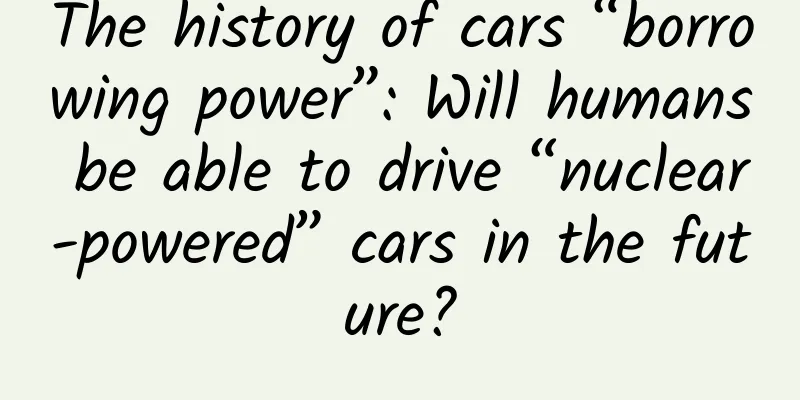The history of cars “borrowing power”: Will humans be able to drive “nuclear-powered” cars in the future?

|
Author: Duan Yuqin, Duan Yuechu, Huang Xianghong, Huang Yanhong In ancient times, the power of vehicles mainly came from human and animal power. People pushed the vehicles forward by pulling the carts or driving livestock (such as horses, cows, etc.). With the advent of the Industrial Revolution, the invention of the steam engine has made a new breakthrough in the power of vehicles. At the end of the 18th century, steam locomotives began to appear, using the power generated by steam to drive vehicles, which greatly improved transportation efficiency. In the late 19th century, the invention of the internal combustion engine laid the foundation for the development of automobiles. The internal combustion engine uses fuels such as gasoline or diesel as energy, converts the energy generated by combustion into mechanical energy to drive the vehicle. This power method has greatly improved the performance and flexibility of the car. Since the 20th century, electric vehicles have also gradually developed. Electric vehicles use batteries as their power source and convert electrical energy into mechanical energy through electric motors. They have the advantages of zero emissions and low noise. In recent years, with the continuous advancement of battery technology, the range and performance of electric vehicles have also been continuously improved. Nowadays, in addition to traditional fuel vehicles and electric vehicles, hybrid vehicles are also gaining more and more attention. Hybrid vehicles combine the advantages of internal combustion engines and electric motors, and can automatically switch power sources according to different driving conditions, improving fuel efficiency and the environmental performance of vehicles. Copyright images in the gallery. Reprinting and using them may lead to copyright disputes. In general, the development of vehicle power has gone through a process from human and animal power to steam power, and then to internal combustion engines, electric motors and a variety of power combinations, which has continuously promoted progress in the field of transportation. In the past few decades, countries including the United States, the Soviet Union (Russia), France, and Switzerland have conducted research on nuclear-powered cars. The United States has made some attempts in the field of nuclear-powered vehicles. For example, Ford Motor Company launched the nuclear-powered car concept model Nucleon in 1958. It generates heat by splitting uranium to heat water into steam, and then uses steam to drive the turbine to generate power to drive the vehicle. However, due to some technical difficulties, it has not entered the actual production stage. In 2009, Cadillac Motor Company also launched a nuclear-powered concept car WTF that uses thorium as fuel. The idea of this car is that it can run for 100 years without refueling or repairs, but it is still in the research and development stage and there is still a long way to go before large-scale commercial use. The Soviet Union also conducted research and development of nuclear-powered cars in the 1960s. In 1965, a 320-horsepower car prototype, the "Volga-Atom", was launched, but during testing it was found that the car was prone to overheating and was very slow, so the project was later abandoned. In addition, the Soviet Union also produced vehicle-mounted nuclear reactor equipment such as the TES-3 mobile nuclear power plant and the Pamir-630d mobile nuclear power plant. The French car company Simca exhibited a nuclear-powered concept car called Fulgur at the 1959 Geneva Motor Show. In addition, Audi has also launched a nuclear energy concept car. In 2014, Audi launched a model codenamed Mesarthim F-Tron Quattro. Its nuclear reactor is placed in the middle and rear of the car body. The working principle is to generate steam by "boiling water" to generate electricity for the motor, and finally drive the four wheel hub motors to drive. It is said that Audi has successfully completed nuclear fusion, but because it cannot solve the problem of nuclear radiation and nuclear waste disposal, there has been no news about this concept car since then. Nuclear-powered vehicles have the advantages of requiring less fuel, no exhaust emissions, and abundant fuel reserves. However, they also have risks such as nuclear fuel leakage, as well as technical difficulties in terms of nuclear reactor size, nuclear protection, and cost. Currently, nuclear-powered vehicles are still in the research stage and have not yet been commercialized. Nuclear energy is a powerful energy source with high energy density. However, there are still many technical and safety challenges in applying nuclear energy to the automotive field. From a technical point of view, miniaturizing nuclear energy and safely applying it to vehicles is an extremely complex issue. The design, protection and cooling systems of nuclear reactors all require highly sophisticated technical support and must ensure that they can work stably and reliably under various conditions during vehicle operation. In terms of safety, the use of nuclear energy involves the handling and protection of radioactive materials. Once an accident occurs, it may cause serious radioactive pollution, posing a huge threat to the environment and human health. Therefore, extremely strict safety measures are needed to ensure the safe operation of nuclear energy vehicles. In addition, the promotion of nuclear-powered vehicles also needs to consider the degree of social and public acceptance. Since people have certain concerns about the safety of nuclear energy, it may take a lot of publicity and education to make the public accept nuclear-powered vehicles. Although it seems that the realization of nuclear-powered vehicles faces many difficulties at present, with the continuous advancement of science and technology, it may be possible to find solutions to these problems in the future. However, in the foreseeable future, the widespread use of nuclear-powered vehicles still faces great challenges. |
>>: From ancient Greece, the "intoxicating journey" of beer begins...
Recommend
Did you choose the wrong toothpaste and toothbrush? I've been brushing my teeth for so many years, but it turns out I've been doing it wrong...
Compiled by: Gong Zixin Effective brushing It not...
Which industries are suitable for information flow?
Question 1: I have a question: Regarding the prob...
"Low-sugar" mooncakes cause diarrhea? Thanks for the invitation! The culprit turned out to be this
Expert of this article: Pa Lize, chief physician ...
Experiments to ignite user growth: A/B testing best practices
In order to achieve scientific growth in the seco...
OPPO Reno6 Pro review: Put the summer sea in your pocket, a real "dessert" phone for young people
In OPPO's mobile phone product line, the Reno...
156 sets of high quality cosmetics wedding dresses chemical dreamweaver source code free download
156 sets of high quality cosmetics wedding dresse...
Review of semi-finished food delivery service: Can you save time and effort while also having deliciousness and health?
If you have already formed a small family and hav...
User operation: How to make use of private domain traffic?
What is private domain traffic? Why do we need pr...
Be prepared, stay healthy! When you are on the road, prepare a first aid kit!
Whether you are going home for the New Year or tr...
Activities, teams, promotions, tools, guaranteed to be the most comprehensive new media operations guide you have ever seen!
The rise of mobile Internet has made the college ...
Zhejiang University team creates new substances, and the results are published in Nature
Ceramics and rubber are two materials that we oft...
These water sources are special. If used properly, they can make water "regenerate"!
When it comes to water sources, the first thing t...
About user behavior path: How to guide traffic?
Let’s first define the user path. The user path r...
From naked eyes to luxury, a review of classic TVs from IFA
IFA2015 is about to open. As one of the most famo...
Three operational insights I gained from a Spring Festival red envelope event
During the Spring Festival, we planned a red enve...









